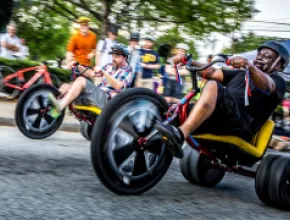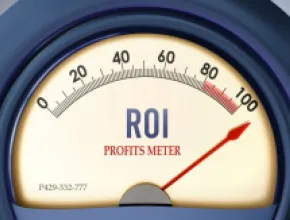Designing meeting breaks that contribute to productivity and retention may be just as important to fulfilling objectives as the program content itself.
And with many organizations strapped for time and money these days, breaks can be an affordable and efficient way to give attendees a refreshing energy boost between intensive sessions.
Trainers, planners and hotel staffers who work with business groups say the most effective meeting breaks involve engaging activities such as fun play, teambuilding or networking.
Design Meeting Breaks with a Purpose
According to Andrea Sullivan, president of BrainStrength Systems, a company that provides corporate training and learning services using scientific research, the fact that the human brain changes with every experience, even silence, is something to consider when planning meeting breaks.
“People can listen only so long at a time, especially nowadays when people have so much on their minds,” Sullivan said. “After they’ve listened to a speaker/presenter for a certain amount of time, even 15 or 20 minutes, they need to make a shift to some kind of active participation or even quiet reflection.”
Noting that the aim of most meeting objectives is to have people make use of the information presented, she said that the information will stick better with attendees if presented in conjunction with a learning activity.
One break idea Bonnie Wallsh, a meetings educator and chief strategist at Bonnie Wallsh Associates, advocates is to have inviting seating areas near the main meeting room where people can go during breaks to discuss what they learned in a session.
“Give people the chance to grab something to eat and sit down in clusters to talk about what inspired them or what they are motivated to do as a result of what they just heard,” she said.
“We used to have 15-minute bathroom and stretch breaks in meetings, but now you can build an educational session into your breaks,” Wallsh continued. “Make it part of the learning process to get people to think out of the box. This style is especially good for younger people who don’t want to sit around and listen to a speaker—you really have to engage them.”
Wallsh says discussion during breaks can be used back in the main session. Have a “scribe” write down the ideas and comments that come out of the conversation during breaks.
Lists can be compiled for attendees to take with them, either electronically or in print form displayed on session room or break area walls.
Louise Upshaw-McClenny, managing director for the Global Advisory Network, a company specializing in the development, facilitation and management of Customer Advisory Boards (CABs), believes that meeting breaks should have a strong purpose.
“Attendees should see the breaks as part of the reason they are there,” she said. “Perhaps you do networking activities or teambuilding.”
Upshaw-McClenny noted that there are many ways to design breaks with purpose. For example, networking activities can involve people circulating around a room to interview each other in order to learn about common interests.
People who have certain things in common can then interact and get acquainted.
“For teambuilding, groups can work on a fun project such as constructing a building of Tinker Toys or doing a scavenger hunt around the meeting facility,” she said. “Direct teams to bring back a housekeeper’s apron, a chef’s hat and the like.”
To promote learning during meetings, Upshaw-McClenny likes to send attendees to find specific information on various websites, perhaps even the sponsoring organization’s site.
“There are many fun ways to do this with technologies,” she said.
“You can use social media like LinkedIn or Facebook to find out information about customers, competitors or even fellow attendees,” she added.
Upshaw-McClenny also noted that it’s often a good idea for attendees to get out of the meetings environment.
“For any break, it’s good to get people out of the meeting room, maybe outdoors into fresh air,” she advised.
Get Your Attendees Moving
Breaks that offer physical activity and maybe some fun are great ways to keep people engaged with meeting content.
Whether it’s billiards, basketball or scavenger hunts, planners and suppliers advocate physical movement as a great tool to keep people motivated and provide some stress relief.
“We have brought remote control cars into our conference wing,” said Laura (Batchelor) Smith, former director of operations for The Chattanoogan Hotel & Conference Center in Chattanooga, Tennessee. “People love racing them down the hallways because they are using the other side of the brain. We’ve also used remote control boats on our pool.”
At Glen Cove Mansion Hotel and Conference Center, located outside New York City in Glen Cove, New York, videogame tournaments are popular ways to break up training sessions and other meetings in any season, said Fred Leuthold, who was director of sales and marketing when this article was written.
When weather is good, there are plenty of outdoor options, he added.
“We have 65 acres of grounds here, so organizers can have their groups do many activities during breaks like tennis, basketball and racquetball,” he said.
Lighthearted play is a good way to refresh and energize attendees, according to Nat Measley, adjunct faculty member at Horn Entrepreneurship and former owner of The Fun Department, a teambuilding company based in Newark, Delaware.
He said that when people have permission to play, their ears and eyes are more open, barriers break down and positive alliances are formed.
An example of such activity is a “Who Am I?” game in which organizers put a leader on one side of the room and a second on the other. When a fact about one of them is presented, people are asked to stand by the leader they think the fact describes.
“People who pick the right person stay in the game,” Measley said. “It’s a simple way to get people out of their seats and the blood flowing.
“We work closely with our clients to learn their culture and find just the right ways to break up meetings,” he continued. “We look at the beginning, the middle and the end of the program to see where we can help with icebreakers, break activities and so on.
“Our recommended formula is 75% meeting, 25% fun,” he added. “We’re business-savvy people with a serious purpose—making fun counts toward goals.”
At Hershey Resorts in Hershey, Pennsylvania, convention services staff recommend health and wellness options for meetings breaks, which can be customized according to objectives and preferences. The options include cupcake making, chocolate martini mixology classes, scavenger hunts, Hershey history tours and spa treatments.
“Some of our most popular breaks come from our chocolate-inspired spa treatments,” said Jill Cecala, director of northeast sales and marketing for Hershey Resorts. “Chair massages and yoga stretching are both very popular. Some people just do an outdoor break for a walk around our property because the fresh air and exercise helps keep people going as well.”
Thought and Energy Food
According to Sullivan at BrainStrength Systems, food plays a big role in keeping attendees alert, energized and receptive to learning through a long conference day.
“What we eat greatly influences how we think and how we feel,” she said. “Food choices should be targeted to specific meeting objectives.”
She advised staying away from items made with white flour and sugar, as they cause “brain fog.” Better choices are granola bars, fruit and the like.
“Drinks can include soda—which people have to monitor for themselves—orange or vegetable juices,” she said. “Tea and coffee are okay in small quantities, and of course, plenty of water.”
Wallsh agrees, adding that planners should “design your foods for brain-friendly interaction. I have seen people do red and blue breaks that feature fruit, such as plums and blueberries which help the brain think.”
Kristy Cook, director of sales for Affairs to Remember, an Atlanta-based catering company, said many clients want break food that is quick and healthy.
“We find fruit snacks, granola bars and trail mix are very popular today,” she said.
“We also like to get people outdoors, and when we do we can include an ice cream cart or popsicle stand for them to sample,” Cook added.
RUTH A. HILL was a former frequent contributor to Meetings Today.
This article was originally published in 2010 and updated October 2019.
[Read This Next: Using Science to Create a Better Meetings Experience]






